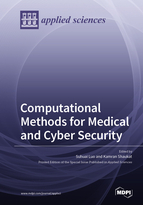Computational Methods for Medical and Cyber Security
A special issue of Applied Sciences (ISSN 2076-3417). This special issue belongs to the section "Computing and Artificial Intelligence".
Deadline for manuscript submissions: closed (30 June 2022) | Viewed by 46187
Special Issue Editors
Interests: computer vision; cyber security; data mining; image processing; bioinformatics
Special Issues, Collections and Topics in MDPI journals
Interests: artificial Intelligence; data science; machine learning; cyber security; health informatics
Special Issues, Collections and Topics in MDPI journals
Special Issue Information
Dear Colleagues,
Over the past decade, the use of computational methods, machine learning (ML), and deep learning (DL) has been exponentially growing in developing solutions for various domains, especially medicine, cybersecurity, finance, and education. While these applications of machine learning algorithms have been proven beneficial in various fields, they have also highlighted many shortcomings, such as the lack of benchmark datasets, the inability to learn from small datasets, the cost of architecture, adversarial attacks, and imbalanced datasets, to name a few. On the other hand, new and emerging algorithms, such as deep learning, one-shot learning, continuous learning and generative adversarial networks, have been successfully applied to solve various tasks in these fields. Therefore, it is crucial to apply these new methods to life-critical missions and measure these less-traditional algorithms' success when used in these fields.
Authors are welcome to submit their papers focusing on but not limited to the following topics: machine learning, explainable machine learning, adversarial machine learning, cyber security, imbalanced datasets, bioinformatics, medical diagnosis, financial risk management, finance, asset return forecasting, stock exchange, educational data mining, learning analytics, student performance prediction, and intelligent tutoring systems.
Prof. Dr. Suhuai Luo
Mr. Kamran Shaukat
Guest Editors
Manuscript Submission Information
Manuscripts should be submitted online at www.mdpi.com by registering and logging in to this website. Once you are registered, click here to go to the submission form. Manuscripts can be submitted until the deadline. All submissions that pass pre-check are peer-reviewed. Accepted papers will be published continuously in the journal (as soon as accepted) and will be listed together on the special issue website. Research articles, review articles as well as short communications are invited. For planned papers, a title and short abstract (about 100 words) can be sent to the Editorial Office for announcement on this website.
Submitted manuscripts should not have been published previously, nor be under consideration for publication elsewhere (except conference proceedings papers). All manuscripts are thoroughly refereed through a single-blind peer-review process. A guide for authors and other relevant information for submission of manuscripts is available on the Instructions for Authors page. Applied Sciences is an international peer-reviewed open access semimonthly journal published by MDPI.
Please visit the Instructions for Authors page before submitting a manuscript. The Article Processing Charge (APC) for publication in this open access journal is 2400 CHF (Swiss Francs). Submitted papers should be well formatted and use good English. Authors may use MDPI's English editing service prior to publication or during author revisions.
Keywords
- machine learning
- reinforcement
- explainable machine learning
- adversarial machine learning
- adversarial attacks
- cyber security
- intrusion detection systems
- malware
- imbalanced datasets
- bioinformatics
- medical diagnosis
- asset return forecasting
- learning analytics
- intelligent tutoring systems







